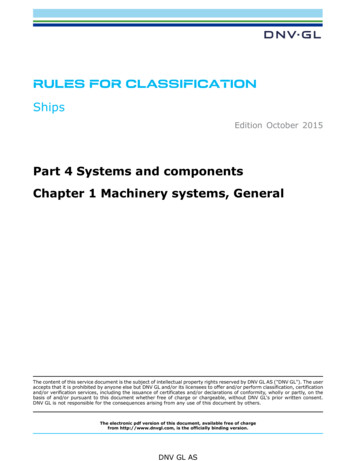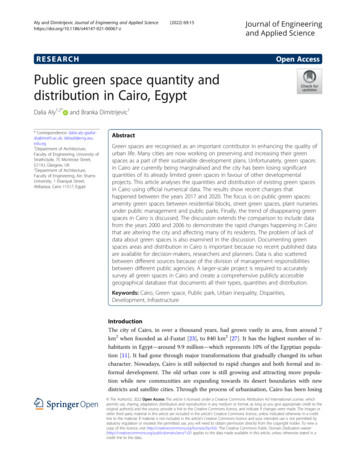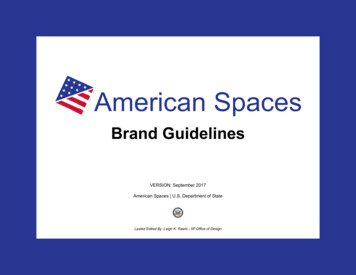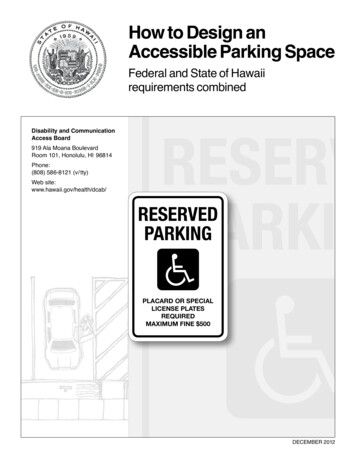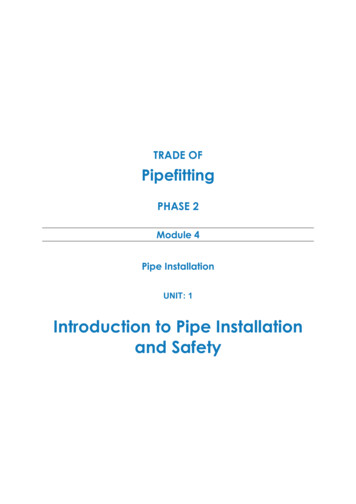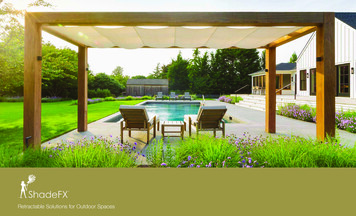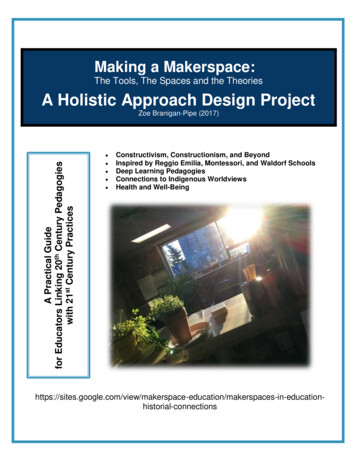
Transcription
Making a Makerspace:The Tools, The Spaces and the TheoriesA Holistic Approach Design ProjectA Practical Guidefor Educators Linking 20th Century Pedagogieswith 21st Century PracticesZoe Branigan-Pipe (2017) Constructivism, Constructionism, and BeyondInspired by Reggio Emilia, Montessori, and Waldorf SchoolsDeep Learning PedagogiesConnections to Indigenous WorldviewsHealth and ctions
Table of ContentsAcknowledgements .ivAbout the Author .vIntroduction .1The Makerspace Classroom Design Project.2Chapter One: Makerspaces in Education .6Historical Pedagogical Connections in Schools .6Constructivism, Constructionism and Makerspaces .10Key Influencers of Makerspaces .11Connections to Indigenous Approaches and Constructivism .19Chapter Two: Classroom Design and Learning Spaces.24Learning Spaces and The Environment as a “Third Teacher” .25Elementary Classroom Design #1 .27Elementary Classroom Design #2: .35A New Approach – Research-Focused and.35Intentionally Designed .35Chapter Three: Program and Lessons .40Connections to Physical and Mental Health and Mindfulness .40Social Justice, the United Nations, and.43World Issues Connections .43Classroom Lessons .45Literacy and Poetry - Minecraft and Robert Frost . 45Minecraft and Poetry- The Road Not taken. 46Fractals, Math and Interconnections . 49Textiles and Sewing . 54The Altier and Art – A Reggio Approach . 59Financial Literacy Lesson . 63Chapter Four: Maker Tools and Student Resources.67Dash & Dot .67Knitting & Crocheting .68Arduino .69Breadboard .703-D Designing .71Makerblock .72OZOBOT .73Sewing Machine .74Make with Spreadsheets .75Conductive Paint .76Maker Resources .77Starting a small Makerspace in your school? .77Conceptual Framework for Connecting Makerspaces.80with Pedagogy Holistic Approach.80ii
Pedagogical Connections and asking Why?.83United Nations Sustainable Development Goals, Integrated Curriculum .95BRAINSTORM ACTIVITY.95PROVOCATION ACTIVITY .97United Nations Sustainable Development Goals .97CURRICULUM CONNECTIONS .99RESOURCES . 109Linking Pedagogy and Makespaces. 109Pedagogies, Theories and Methods . 109Waldorf Schools Resources: . 109Constructivism, Constructionism Resources: . 111Design Thinking Resources: . 113Makerspaces Resources: . 114Montessori Resources: . 117Emilia Reggio Resources and Links . 119Resources for Teaching and Learning using Indigenous Practices in the Makerspaceclassroom . 121Makerspace on Social Media . 122Makerspace Articles of Interest . 123New, Old and Upcoming Robotics, Programming . 124– A Collaborative List of Resources (always being updated) . 124Discussion and Conclusions . 131References . 135iii
AcknowledgementsI would like to acknowledge and dedicate this project to my family.First, I thank my father, Douglas Branigan (1944-2017), an accomplished wood-worker,designer, and artist, for inspiring me to be a Maker and activist. Many of his artifacts anddesigns remain in both Makerspaces showcased in this project. My mother, Sheri Selway, anexperienced teacher and social activist, has always been my mentor and support. My focus onsocial justice, community action, and relationships are a direct result of her influence.My husband Brad has not only supported my ideas and enthusiasm toward this project, but hehas supported every single crazy project and idea that has led up to this. He has been mysoundboard, a shoulder to cry on, an editor, a cook, and whether it be early in the morning orlate at night, he has also been my driver and delivery person from Makerspace to Makerspace.My sons, Jackson and Nathan, motivated me throughout my journey to be a constructivisteducator and leader, and they helped me see a different way of learning and encouraged meto try different approaches – not to mention, helped me learn to code and build in Minecraftand Java.Second, I would like to acknowledge my co-workers, Beth Carey, Kristy Luker, Ben Nywening,Tammy Faux, and Gerry Sheafer who worked with me as we all have made the shift from atraditional classroom model to teaching using a Reggio-Papert constructivist approach.Last, I would also like to acknowledge my many online colleagues who are also changeagents, educators, and academics, and were (and still are) the catalysts to push me out of mycomfort zone, to think differently about education, and always showed care supported alongthe journey. There are many – but to name a few who have also become my friends, I’d like toacknowledge: Rodd Lucier (@thecleversheep); Ben Hazzard (@benhazzard); Kathy Cassidy(@kathycassidy); Dr. Alec Couros (@courosa); Dr. Camille Rutherford (@crutherford);Jenny Ashby (@jjash); Doug Peterson (@dougpete); Andy Forgrave (@aforgrave); WillRichardson (@willrich45); and Dean Shareski (@shareski).A special thanks should be extended to my colleagues and supervisors at Brock University,particularly Dr. Susan Drake and Dr. Camille Rutherford who have be patient, flexible, andunderstanding every time my vision or direction of this project changed. It has been a privilegeto work with academics who recognize that teaching and learning is changing and whocontinue to support new and current research.iv
About the AuthorZoe has taught in the classroom for thelast 16 years. Zoe is an award-winningeducator with recognitions that includethe Canadian Microsoft Educator (MIE) ofthe Year (2014) and the first place KenSpencer National Award for Teachingand Innovation (2016).She is presently a teacher for the GiftedProgram at the Hamilton-WentworthDistrict School Board (HWDSB) inOntario where she has received aProfiling of Excellence Award forinnovation and creativity.Zoe is also an instructor for Brock University’s Faculty of Education for Social Studies, History,and Geography and Junior Division Qualifications. Zoe’s teaching methods are mostinfluenced by John Dewey, Reggio Emilia methods, and Seymour Papert, who are all strongproponents of teaching/learning through inquiry, making/doing, play, and real-worldexperiences. Zoe blogs and tweets about social justice, community matters, 21st centurylearning, and health and fitness.You can visit Zoe’s blog at http://pipedreams-education.ca, and can follow her on Twitter at@zbipipe.i
IntroductionThe purpose of this project is to build capacity in others who wish to create a Makerspace intheir classroom or school, and to understand the traditional pedagogies and approaches thathave directly impacted the Makespace Movement. This movement continues to gainmomentum, as evidenced by the not only the increase in Makerspaces being developed inschools, libraries, and communities across the globe, but also by the fact that the ideasinspired by Jean Piaget’s theories of constructivism are being discussed and implemented aspart of new pedagogies in the 21st century.This resource is intended to:(1) Inspire and support educators who wish to better understand, articulate, and reflect on thepedagogies and teaching approaches that connect to the design and implementation ofMakerspaces in the classroom or school environment. While there are many methods andapproaches identified in this resource, I hope that educators can take what they need – forinstance, a lesson, a classroom design idea, or even a better understanding of the theories thatare related to constructivism.(2) Showcase The Makerspace Design Project (the creation of a Reggio-inspired Makerspace)through pictures and design examples to help educators collect ideas and connect practice withpedagogy.(3) Bring transformative and progressive approaches to teaching in a mainstream educationprogram by demonstrating how past practices are being embraced through the MakerspaceMovement.(4) Provide a conceptual framework that links to the development of a holistic Makerspace.(5) Provide a template and lesson examples that connect Makerspaces to deep thinkingpedagogies.(6) Assist teachers in articulating and reflecting on their practices.(7) Offer insight into how and why teachers are central to teaching and learning in the 21 st centuryand what a holistic and constructivist inspired approach looks like in practice, specifically as itrelates to a Makerspace learning environment.This project was designed, researched and written as part of a Major ResearchPaper (MRP) for the Graduate Program at Brock University and was part of aqualitative conceptual study.1
Can you imagine a learning space where nature, music, art, and literature are infused in thedesign of the STE-A-M (Science, Technology, Engineering, Art, and Math) focused room? Aspace that celebrates community through nutritious food prepared each day by students whogather at a cafe bar or surround a kitchen table, and are prompted by in-depth discussions ofinnovation and creativity? A space for people of all ages? A place where tea is served at thestart and end of each day in beautiful porcelain cups – where there are no bells or distincttransitions and subjects are infused with big ideas or themes?Image 1: Picture from a Blog Post: “The Third Teacher: From Classroom to Cafe - A Learning Space for All.”After 15 years as a teacher-leader in education innovation and 21st century practices, inSeptember 2014, I began the task of co-creating a Makerspace classroom for studentsparticipating in a Gifted Program who range in their abilities, interests, and ages. But whatseparates this Makerspace from others is its holistic approach to mind, spirit and body.As a team, we implemented conditions to facilitate the characteristics of deep learningPedagogies (Fullan & Langworthy, 2013). We drew from the research and philosophies of theReggio approach (founded by Loris Malaguzzi, 1920-1994), The Waldorf School (founded byRudolf Steiner, 1861-1925) and the Montessori approach (founded by Maria Montessori, 18701952). These philosophies are growing in influence in North America and have many points incommon (Edwards, 2002). They all share in the idea that learning is constructed through (1)inquiry-based learning experiences which are authentic and connected to real world problems;(2) learning environments that facilitate deep thinking and are rich with resources, nature, andbeauty; (3) hands-on, personalized, and varied learning opportunities; (4) a secure connection2
to the outside world and social justice; and (5) a strong focus toward the social and emotionalwell-being of each individual.Background ContextThe Enrichment and Innovation Centre Makerspace was awarded the first place CanadianEducation Association (CEA) Ken Spencer Award in June 2016 after being recognized as atop innovative classroom environment including the flexible, human-centric nature of thelearning program.The video submission showcasing this classroom is found here.https://www.youtube.com/watch?v p7xVW7ojtbs.After receiving additional funding, along with the success of this program, the school districtopened a second Makerspace classroom. A team of educators, students, and parents workedin creating a unique learning space that is considered a Reggio-inspired Makerspaceenvironment – because it used established theories and frameworks from Jean Piaget’sconstructivism and with a strong focus on Indigenous principles and worldviews. This processtook about six months from conception to completion with many meetings, discussions, andrevisions; in January 2017, the new space was officially opened for students and teachers.With this initiative, there was also time to be given for research, ensuring that the project wouldalign with current 21st century teaching methods, district initiatives, and teaching strategies thatare universally designed and innovative and enriching for students and teachers.The Makerspace classroom design project demonstrates examples of howsome of the characteristics of constructionism, constructivism and learnercentric teaching approaches based on the theories of Emilia Reggio, Montessoriand Waldorf schools can be incorporated into a classroom Makerspace whilealso incorporating Aboriginal worldviews and perspectives, mindfulness and lifeskills that might translate into teaching and learning at the classroom level.The Makerspace Design Project: Description and GoalsMakerspaces are very popular in the 21st century learning context because such approachesare so closely linked to constructivist theorists whose research – for many decades – haspointed to the fact that when students are active participants in their learning through play andmaking, they are engaged in their own learning process. This, then, enables deep andmeaningful learning to take place. As this resource aims to demonstrate, and as pointed out byResnick (2015), Professor of Learning Research at the MIT Media Lab, “just making things isnot enough” (p. 164).3
Lee Martin, of the University of California (2015), also points out in his detailed research on theMaker Movement in Education, that,the history of the adoption of computers in schools suggests a lurking danger: TheMaker Movement that assumes its power lies primarily in its revolutionary tool set, andthat these tools hold the power to catalyze transformations in education. Given thegrowing enthusiasm for making, there is a distinct danger that its incorporation intoschool settings will be tool centric and thus incomplete. (p. 37)There are many different approaches to making things, and some lead to richer learningexperiences than others. Moreover, most involve the integration a variety of curriculum withmany layers, real-world learning, and the use of a cross-curricular approaches using real-worldproblems and critical thinking.Therefore, the following goals and ideas describe the foundation for this project:1. Draw on the following questions: Can a Makerspace classroom go beyond STEM (Science, Technology, Engineeringand Math) and to have a more holistic perspective of the student, including theHumanities, Visual Arts and Music? How does the physical environment in a Makerspace impact the role of the teacheror student and does the classroom environment impact our teaching methods? Howare Teachers connecting the use of Makerspaces at the school level to past andpresent pedagogy?2. Create a Makerspace classroom that is holistic in nature: Use theoretical frameworks specifically which focus on the pedagogies andapproaches that connect directly to the Makerspace culture including (but not limitedto) theoretical conceptions from Dewey, Piaget, Montessori, Papert, and Malaguzzi,and inspired by Emilia Reggio methods, and Montessori and Waldorf schools3. Develop a series of inquiry-focused lessons and resources: Maker lessons encompass a wide variety of teaching methods and philosophies thatare connected to design thinking, wicked problems, and critical literacy Lessons allow room for flexibility, collaboration, and cross-curricular integration,including the Arts4
Makerspace Classroom Design: Project OutcomesThroughout the process of creating this learner-centered and multifaceted Makerspace, theteachers involved gained: Stronger understanding of the complexity in creating a learning environment thatincorporates the Reggio Emilia and Montessori and Waldorf Methods in a public-schoolsetting and how this connects to the student-centred approach and current pedagogies Valuable collaboration and team building skills associated with design thinking, actionresearch, teacher inquiry, problem solving and the creation of lessons that were crosscurricular and used a constructionist approach A greater understanding of networking and professional development through socialnetworking tools like Twitter, Blogging and Instagram as well as presentation skills atconferences and showcase events A stronger understanding of Makerspace tools and projects and implementation in ameaningful way A meaningful way to connect practice to pedagogy Opportunity to practice creating classroom lessons that focused on a variety ofconceptual frameworks and being able to articulate each framework depending on thecontext, the environment, the teacher and the learner The opportunity to create teacher through the implementation of lessons andexperimentation with the tools themselves A developed (ongoing) framework to create a human centric makerspace5
Chapter One: Makerspaces in EducationIf there is one thing alone to take from the research, it is that a Makerspace environment iscollaborative in nature, and can occur at a school, a library, a classroom, a shared workspace,a community church, a garage, or a backyard – it is a space where individuals (who areinterested in creating, making, fixing, talking, exploring, inventing, and discovering) gettogether, and it is usually done through self-motivation and direction, personal interest, andwith a willingness to share, learn, and work with others regardless of age, gender, or ability.“Learners make intentional use social interactions where they use one another as experts andmentors and that they make considered and deliberate choices throughout the ‘making’ of theirfinal artifact or project.” (Robbins and Smith, 2016)It is hard to talk about pedagogy, the shift in teaching and what has prompted this projectabout Makerspaces and the Maker culture without briefly mentioning the significant changesthat the school systems underwent at the end of the 20th century and into the 21st century.Here, it is perhaps important to make concrete connections back to how and why the Makerculture is an essential aspect to student learning today.Education has shifted in and out of the constructivist learning approach and while thephilosophies that inspire the Makerspace culture are not new, the term itself is new ineducation; it has roots in methods that span across many decades and have influence fromEurope, the United States, and Europe, as well as from Indigenous Cultures.People might remember attending elementary school when “Making and Tech” courses suchas Home Economics, Cooking, Woodworking, Art, and Instrumental Music were a regulatedpart of the school day, and were included as part of the report card, thus giving these skillsbased, trade-focused subjects a strong sense of purpose and meaning.Is the curriculum and pedagogy heading back to a time in whichhands-on learning approaches and the Arts were strong drivers toteaching and learning?6
Ontario Education Trends“This approach is somewhat out of favor in many of today’s education systems, withtheir strong emphasis on content delivery and quantitative assessment. But theenthusiasm surrounding the Maker Movement provides a new opportunity forreinvigorating and revalidating the progressive-constructionist tradition in education.”(Resnick & Rosebaum, 2013, p. 163)Stephen Anderson and Sonia Jaafar (2003) give a detailed overview of Ontario’s educationtrends in Policy Trends in Ontario Education and explain that during the time of these Makerclassrooms, the curriculum was guided by what is called The Formative Years (1975) in whichmany of the philosophies were steeped in recommendations made by the Hall-Dennis Reportin Living and Learning (1968), including adding to the curriculum areas such as, “the individualand society, decision-making, values, perception and expression, and Canadian Studies”(Ontario Ministry of Education, 1994).The Formative Years curriculum was eventually replaced by the Common Curriculum in 1993,and then again replaced what by curriculum introduced in 1995 during what was referred to asThe Common-Sense Revolution. As these education philosophies and requirements werechanging and many task forces and committees were being deployed, the Ontario noted in theFor the Love of Learning that,there have been changing notions about child development, the nature of teaching andlearning, as well as changes in political trends, fiscal priorities, student enrolments,teacher supply, and other issues. Thus, a core curriculum shifts to a system ofstreaming, with many options and, in time, goes back to de-streaming and what is nowcalled a common curriculum. Over time, teaching strategies also change: as thebenefits of individualized attention are better understood, the emphasis shifts from rigidlesson plans to co-operative, small-group learning and other flexible concepts. (OntarioMinistry of Education, 1994)Individualized learning, small groups, and flexible concepts are rooted inthe very nature of the Maker culture and Makerspaces in classrooms today.7
A major shift how Ontario would approach teaching and learning happened in June 1995,when the Conservative government in Ontario replaced the New Democratic Party (NDP) asthe elected government and made changes to the education system in The Common SenseRevolution, and recognized that these changes impacted how teachers would teach, howschools and classrooms would be organized, and even how educators would be trained andevaluated.Educators were given a direction, and were even given more time to learn and map thecurriculum, and photocopy, enlarge, and laminate the language and math curriculumdocuments; many would be expected to post lists of expectations, curriculum goals, andlearning criteria each day. Oftentimes, teachers would cross expectations off the list as theycovered expectation after expectation, for each strand in every subject of their grade.This curriculum was more specific than the Common Curriculum and had more expectationsper grade to cover. At the time, it seemed like everything was assessed and that everythinghad a rubric or checklist attached. Teachers were focused with teaching and grading everyexpectation including homework workbooks, worksheets, group work, quizzes, home readinglog books, and journals – you name it, and we put a grade on it.The “new” Ontario Curriculum documents; the new report cards; the constant discussion andplanning for the standardized tests; the new leadership model – in which Bill 160 removedprincipals from the Ontario Teacher’s Union; new staff professional development mandates;new school districts – as many school districts were amalgamated; and new home and schoolinteractions mandated by new rules regarding how parent councils would be regulated: thesewere all major drivers for how teachers would teach, what pedagogy would guideprogramming, and how classrooms were organized. These formed the very scripted,organized, scheduled, and planned methods teachers used in their practice. Worksheets,workbooks, and agendas were the norm; in fact, they were not only accepted, but encouraged.It is ironic, however, that this was how Ontario education was changing at the start of the 21 stcentury and, with all these changes, there was very little mention of how technology wouldimpact teachers or learners.Did anyone know that our pedagogies today would become similar tothose that were implemented in The Formative Years or thoserecommendations inspired by the Hall-Dennis Report back in 1968?8
Interestingly, as noted by Anderson & Jaafar (2003), that prior to – and even during – theCommon Curriculum, there were many examples in the elementary school curriculum thatwere steeped in philosophies of student-centred learning, active learning, and individualizationaccording to student learning styles, developmental and academic progress, and interests(The Formative Years, 1975; Education in the Primary and Junior Divisions, 1975).And now, 40 years later in 2017, in Ontario, these very approaches have been increased tonow include Full-Day Senior and Junior Kindergarten and play-based learning, a substantialpart of the Kindergarten and pre-school classroom pedagogies that connects strongly to theReggio Emilia approach, Montessori education, and the Maker Movement. These concepts, inmany ways, can closely be linked to what we considered the fundamental principles ofMakerspaces today – those that encourage interested amateurs and creators to share theirideas with experienced experts and mentors who could help them to design, prototype, anditerate novel solutions to their real-world problems (
part of new pedagogies in the 21st century. This resource is intended to: (1) Inspire and support educators who wish to better understand, articulate, and reflect on the . As a team, we implemented conditions to facilitate the characteristics of deep learning Pedagogies (Fullan & Langworthy, 2013). We drew from the research and philosophies .


